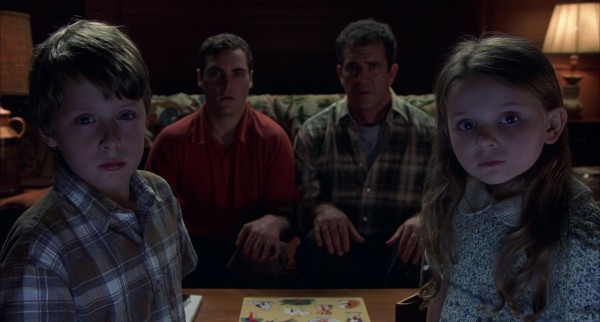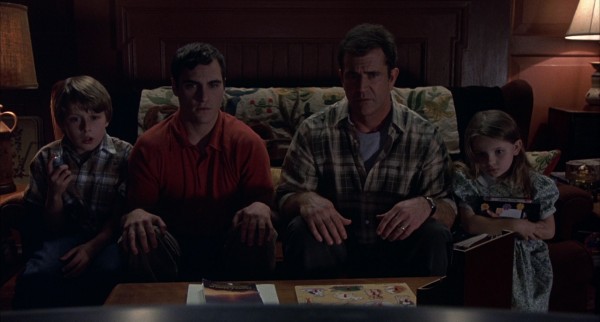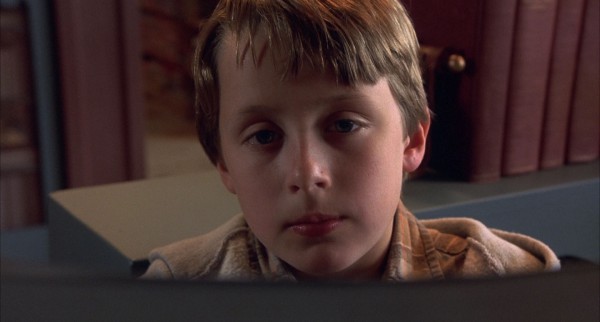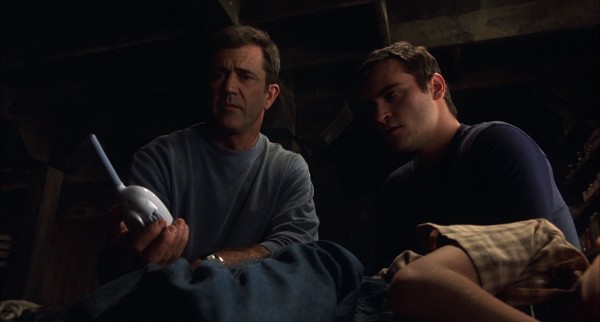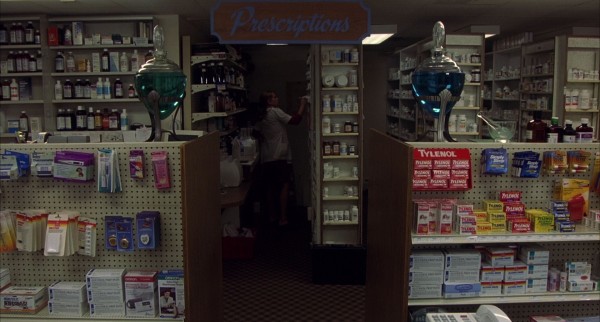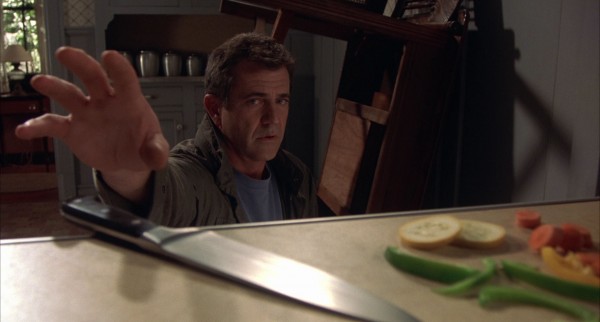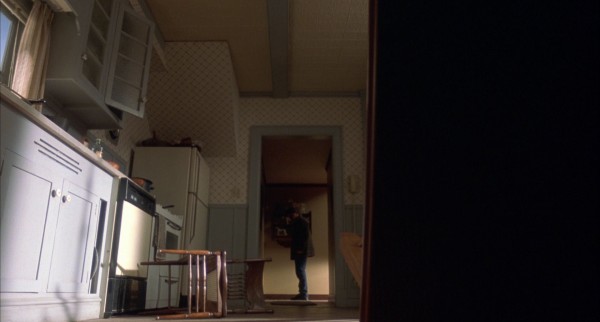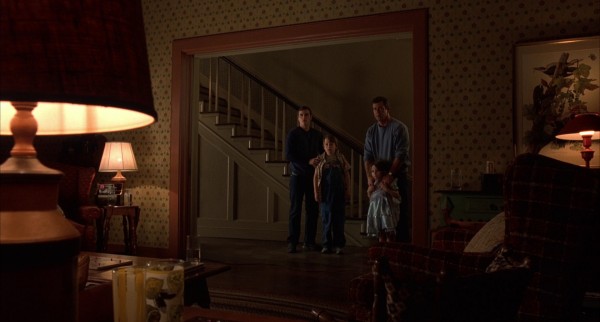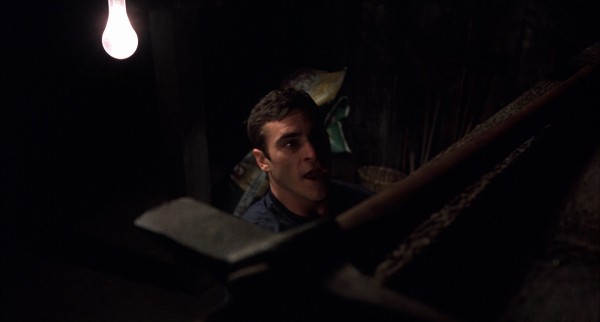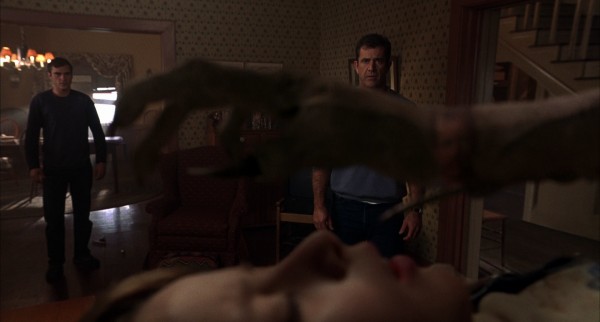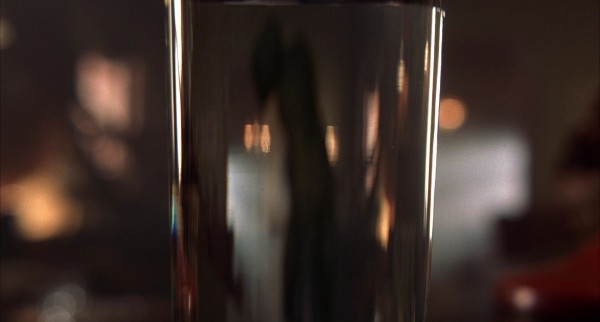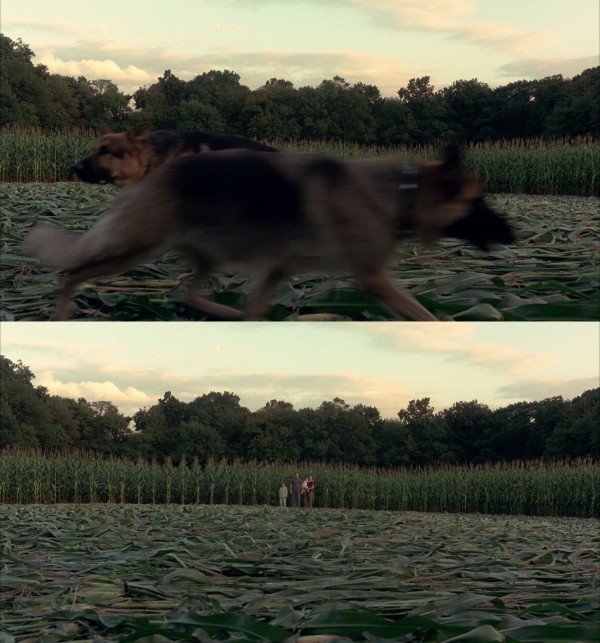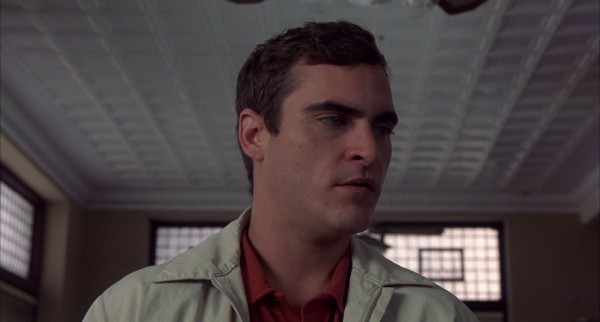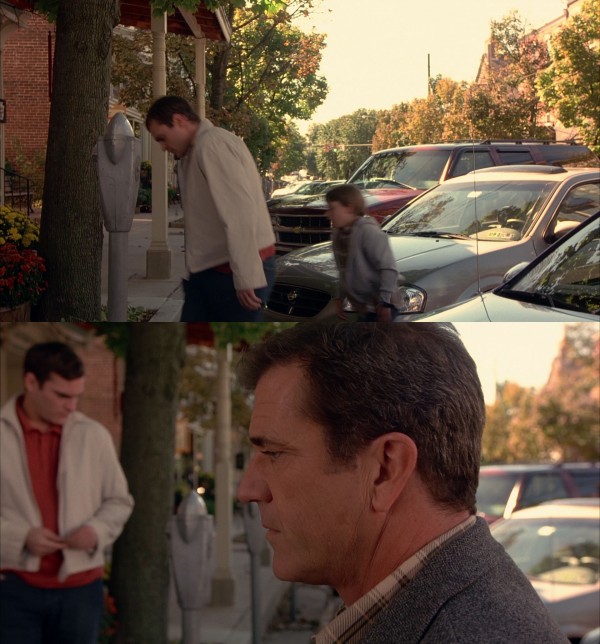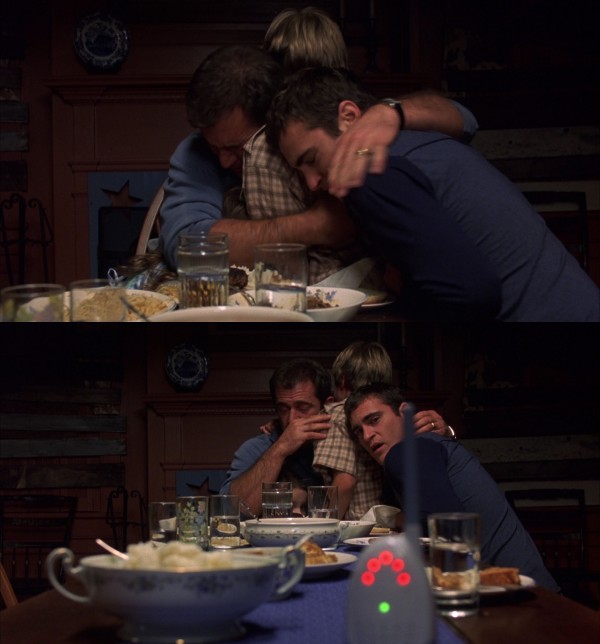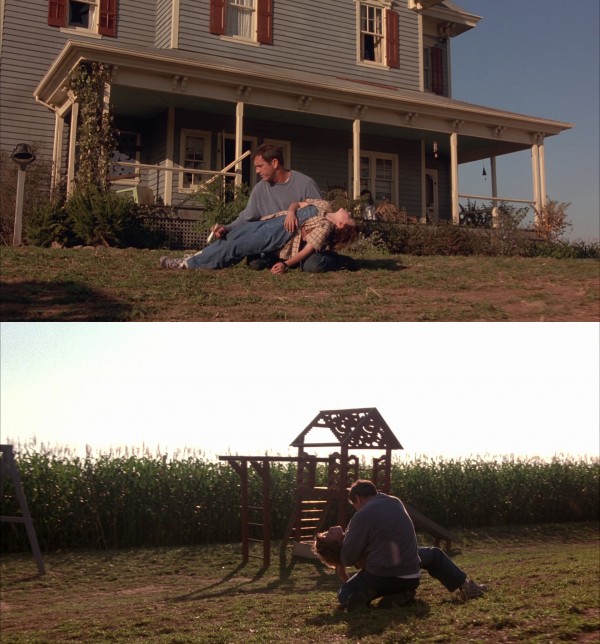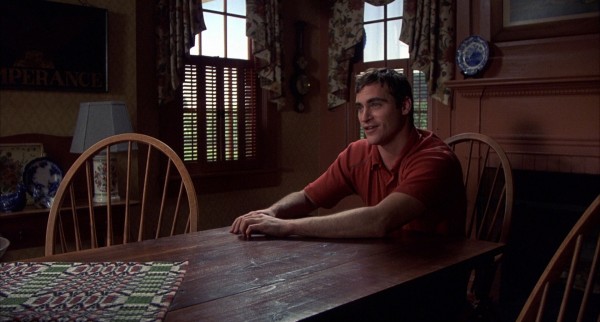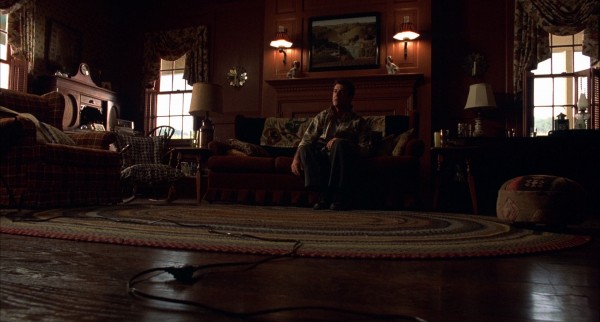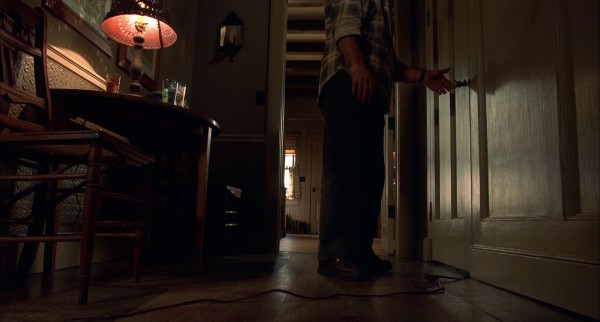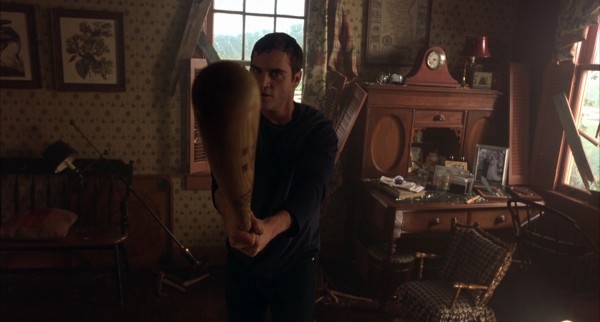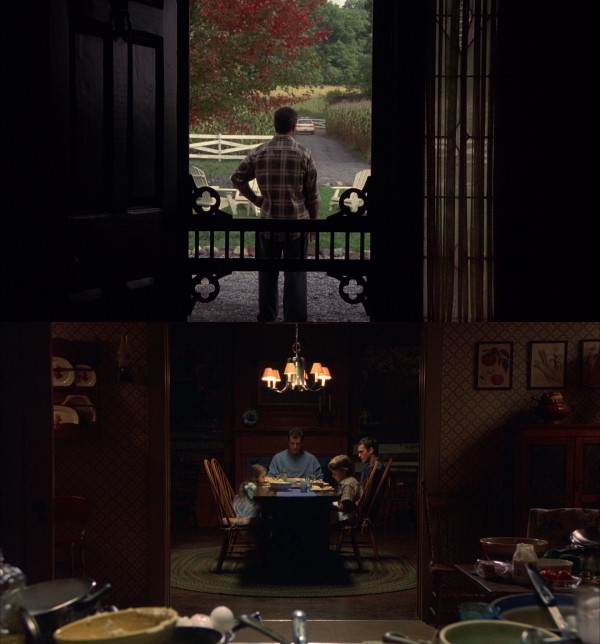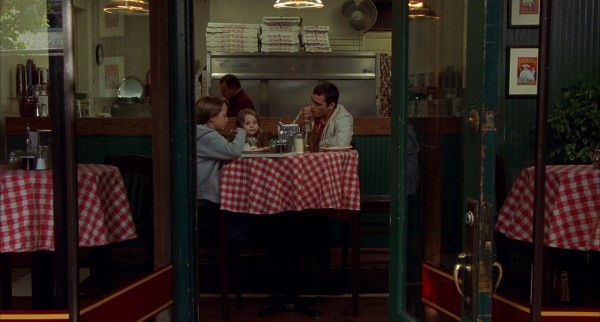
Signs, Part IV: Visual style
This article is part of an analysis project about M. Night Shyamalan‘s five films from 1999 to 2006: The Sixth Sense (1999), Unbreakable (2000), Signs (2002), The Village (2004) and Lady in the Water (2006). This is the fourth article about Signs. The first is here, the second here, the third here. The articles about the other films can be found in this overview.
This article will look at the visual style in Signs. Its formal palette is not as broad, not as thoroughly stylised, not as intricate, as in Unbreakable. It is enough to compare the relatively slight size of the current article against the massive corresponding one about the style of its predecessor. Still, for a mass-market Hollywood film, it is remarkably adventurous. For one thing, Signs is almost devoid of over-the-shoulder shots – film storytelling’s perhaps most basic and prevalent element – which are mainly reserved for the three flashbacks recounting the death of the hero’s wife.
The article consists of the following chapters: a discussion of the film’s long takes and then various formal devices: staging in depth, the technique of block-and-reveal, the many shots of Graham Hess in profile, and the use of camera movement, wide-angle lens and distinctive shot framings. There are two addenda: first some interesting features of film’s sound will be examined, and then there will be a round-up of items that have not naturally fit in with the rest of material in these four articles about Signs.
*
In order to discuss the film properly, I will have to reveal the whole plot, including the plot twist at the end.
For readers unfamiliar with the story of Signs, here is a brief outline of the plot.
Long takes
Even though in almost every department, Signs is a less audacious film than its immediate predecessor Unbreakable, it still utterly flies in the face of mainstream cinema’s fast cutting approach. Perhaps its most daring shot as regards static duration is the 57-second one (above) where Merrill goes upstairs to see if the aliens have left the house. For most of the shot the camera fixedly gazes up the cellar stairs while he slowly ascends, and for 13 seconds it just stares at an empty image, except for strangely luminous shapes on the boarded-up window.
Breaking down the Signs shot duration, we arrive at the following table (compared with Unbreakable and The Sixth Sense):
- 32 takes of 30 seconds or more (U: 61, TSS: 25)
- 7 takes of 60 seconds or more (U:22, TSS: 10)
- 0 takes of 120 seconds or more (U:8, TSS: 1)
There are as many as 53 shots in the 20-29 seconds bracket, however, proving that Signs definitely leans towards a long-take strategy, but on a lesser scale.
The longest takes are
- the film’s last shot, inside the bedroom (97, single-take scene)
- Merrill’s monologue in the late-night conversation about there being two groups of people (87)
- Graham’s monologue in the same scene (86)
- the whole family leaving the cellar for the living room, then being surprised by the Nemesis Alien (80)
- Graham tells Bo the first birth story (72)
- the film’s penultimate shot, the revival of Morgan outside the house (70, single-take scene)
- the food discussion about what to have for their possibly last meal (65, single-take scene)
Other single-take scenes are
- the kitchen scene following Graham’s encounter with the alien in the cornfield (57)
- Merrill going upstairs from the cellar to check if the aliens have left (57)
- Graham taking the clerk’s confession at the pharmacy (27)
- Graham leaving for Ray Reddy’s house (21)
(Look here for a closer examination of Unbreakable‘s long takes.)
Staging in depth
Even though Signs is a far more lively and action-filled work than Unbreakable, its use of stylised staging-in-depth is even more strident. Working in concert with long takes, there are a high number of shots totally at odds with mass-market Hollywood cinema. Like with the slow tempo of The Sixth Sense and the ultra-formality of Unbreakable, Shyamalan again seems to have gotten away with such strange practices, because audiences were already seduced by the ingeniously staged horror scenes. It is not until about 70 minutes into the film, however, when Signs turns strange in earnest. During the segment of the barricading of the house, it descends into a similar mood-piece mode as Unbreakable. That a Hollywood alien-invasion movie should devote an oddly-composed 65-second shot to a discussion of food is rather unexpected, but despite the resolutely everyday conversation, the staging adds a layer of discomfort because they are really planning their last mail, deciding on their favourite dishes:
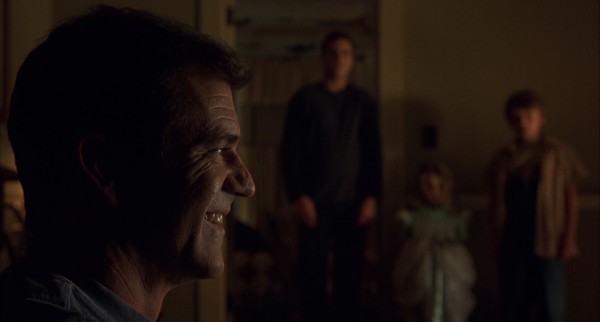
When they later board up the house, Shyamalan provides this intensely stylised shot (the scene’s context is further explained here):
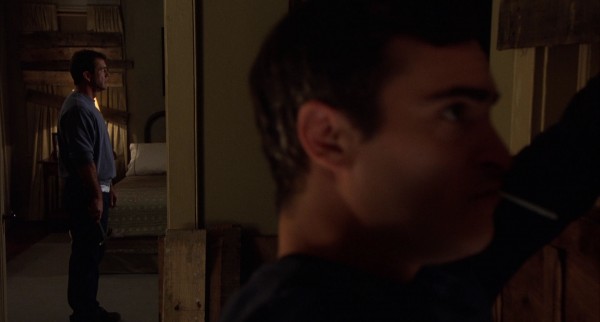
The following 57-second shot is the first one that combines long take and depth in the film, introducing the device in a gentler, more natural fashion, and to particularly good effect. It takes place just after Graham’s horrifying nocturnal encounter with an alien in the cornfield. Like in the previous shots, the characters are divided into planes, occupying three separate worlds – but here they are allowed to cross them:





Although the next scene contains some analytic editing, it is dominated by the following set-up:
It ends with this, the camera repositioned slightly, the top of the TV now occupying the foreground:
Earlier, when Morgan decides to buy the book about extraterrestrials, he thrusts the book upwards so that it enters the shot foreground in a similar way:
In many shots, there is a “discourse” between foreground and the other planes:
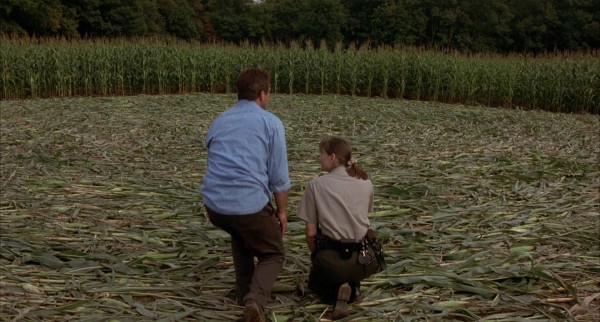
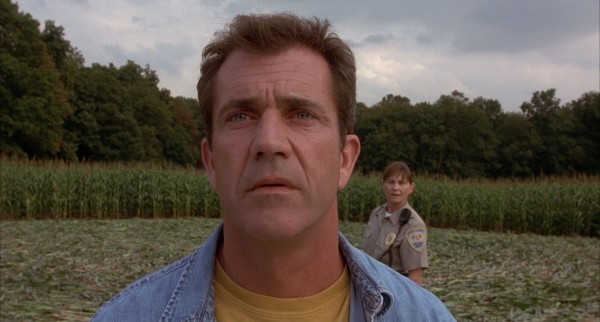
In a rather unique way, the eeriness of the situation is almost entirely provided by the visual oddity. We see a similar set-up in another scene. In addition, it also contains a “geometric” camera movement, a Shyamalan trademark manoeuvre that is less employed in Signs, but Unbreakable was full of lateral movements , and The Sixth sense has an “elevator shot” in the opening scene and during the birthday party. The current shot also features an impossible camera position. It lasts 72 seconds.


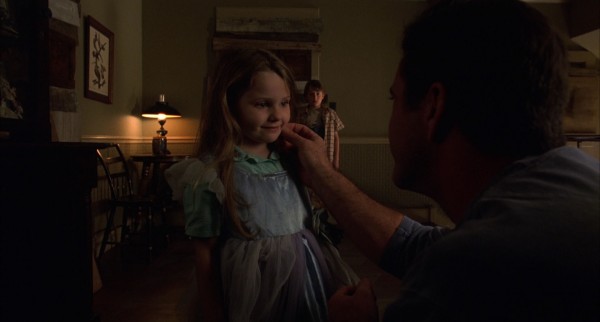
Many of these shots seem divided into stages, in reflection of Shyamalan’s neat and methodical approach to filmmaking. Here is another example, the last shot of the cellar sequence (lasting 56 seconds):


Shyamalan seems at times almost obsessed with employing the shot to its fullest depth, stuffing it with information. During the sheriff’s first visit, through the door we can see her police car in the far background:
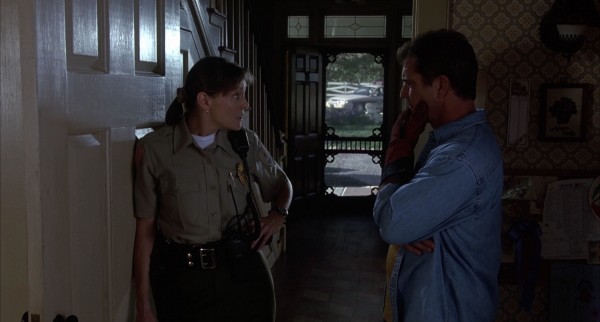
The police car is also important during her second visit, again in connection with the door, in a magic moment of filmmaking:
Starting with a traditional type of shot, it is as if the film gravitates towards its true nature of depth by some invisible force. The shot is further explained here. Another very complex shot, with the dying alien reflected in a TV screen, is explained here. Many of the house shots are also turned into highly distinctive images by use of depth.
The following slide show presents a wide range of other distinctive depth shots, in chronological order:
Block and reveal
Unbreakable saw a new development in the Shyamalan arsenal of style: a block-and-reveal shot that gave many situations an aura of artificiality, encouraging, for example, a feeling of eeriness. In the following innovative shot the dogs function like theatre stage curtains, pulled back to reveal the action, in this case a family immensely dwarfed and vulnerable. This is also a staging-in-depth shot, but where foreground and background are not employed simultaneously:
When Merrill is at the military recruitment office, a voice seemingly coming out of thin air suddenly says, “I’ve got it figured”. The close-up of Merrill is then turned into a depth shot, revealing the owner of the voice:
Later in the scene, another voice comes out of thin air, again blocked by Merrill’s body, but here the speaker is revealed through cutting (see the below slide show). Both situations metaphorically underline Merrill’s less than stellar intelligence – he is always lagging behind, taken by surprise, confused:
At the pharmacy, Graham is forced to listen to the clerk’s confession, and in a light, silly touch we see another customer impatiently stick is head up (a position curiously reminiscent of the sheriff in the crop circle):
In the following example from the opening sequence the effect is reversed, an item blocked rather than revealed (the shot is further explained here):
A profile of Graham Hess
The above shot brings us to a Signs signature shot – its protagonist intruding in the frame in stylised fashion, heavily foregrounded and in profile (strongly reminiscent of Charles Bronson‘s many sudden appearances in Leone’s Once Upon a Time in the West [1968]). Here is another example from the opening sequence, where the others have found Morgan, who has discovered something strange in the cornfield:
The next example is from the family town trip. (The red car in the background belongs to Ray Reddy, the man who caused the death of Graham’s wife. Later, while eating at the pizza parlour, the family suddenly see Ray as he is about to drive off. One could make the case that the way Graham is blocking the car, points forward to the crossing of paths with Ray.)
This is a variation on the theme, but here he does not step into the shot, but the camera lurches sideways to include him:
Camera movement
Two of the film’s most memorable camera movements also deal with reveals. Just as the family are reconciling after the bitter dinner quarrel, the camera, in an almost inhumanly cold and merciless movement down the table, reveals the babycall in the foreground. It has sprung to life, signalling that the alien onslaught is imminent:
Earlier, Graham receives a mysterious phone call, shown through a narrow door opening. When the call is broken, Graham glances towards the door, and there seems to be an almost mystical connection between Graham and the camera – because it starts to slowly recede, revealing a life-size dummy, its colour vividly standing out. At first, the mise-en-scène seems utterly bizarre, but turns out to be one of the film’s most brilliant ideas. (Its many meanings are analysed in detail here and here):
The most majestic reveal comes in the opening sequence, as a helicopter shot unfolds the crop markings in their full extent:
During the climactic battle with the Nemesis Alien, as the family flee the house, there are a number of camera movements rhythmically panning from left to right. The most expansive one is seen below, a Steadicam shot that swings around the characters in an 180 degree circle:
The shot ends with the swing set carefully at the edge of the frame. There seems to be a pattern that many of the shots from the yard shall be “framed” by objects. The following (static) shot sees the swing set at the edge again:
Here camera movement binds, in a stylised, highly artificial fashion, two actions – Merrill realising what has happened in the yard (Bo having been attacked by the dog) and the sheriff removing the meat fork with which Morgan killed the dog – and the shot starts with furniture on the right edge and ends with the playhouse on the left edge:
During the sheriff’s second visit, at one point cutting is replaced by a leisurely camera movement back and forth between two constellations of people at the table. It is a simplified version of the dinner scene in The Sixth Sense, where camera movement “cuts” between Cole and his mother, and the lateral tracking shot back and forth between David and Elijah during their first meeting in Unbreakable:
Wide-angle lens
A new development in Signs is the use of a wide-angle lens to stretch space in an artificial-looking manner. Below, in combination with the familiar camera movement, it enhances the sense of unreality Graham feels after awakening from a dream. It also turns the circular rug into a symbol of almost surreal, engulfing proportions and at the end of the shot the house seems enormously large.
During the final battle there is a shot from the alien’s point of view, where the lens creates a peculiar 3D effect, which also connects to the foregrounding/depth strategy already discussed:
In the pantry door scene, a wide-angle lens is employed in the shot when he decides to leave, elongating the space and making his retreat look faster and more cowardly. The door seems unnaturally tall, belittling him. The same lens is used in the cornfield scene when he encounters an alien, and when he runs away the lens makes him run “faster”, increasing the sense of panic. The lens is also strengthening the parallel between the scenes (further discussed here):
Framings
Signs abounds with interesting frames-within-frames. Here, after the pantry door scene above, the family are discussing what to do. At first, Graham is confused and the rest of the family are separated from him, but when they agree to stay in the house and are in the same boat, they are grouped in the same framing:
This is from the opening sequence, when after Merrill’s rude awakening, window bars are again put to nice use:
Two other highly pleasing frame compositions (yet again playing with staging-in-depth):
Here the use of a door as a framing device is gently supported by camera movement:
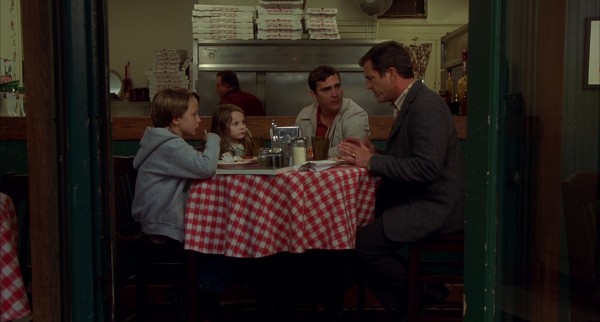
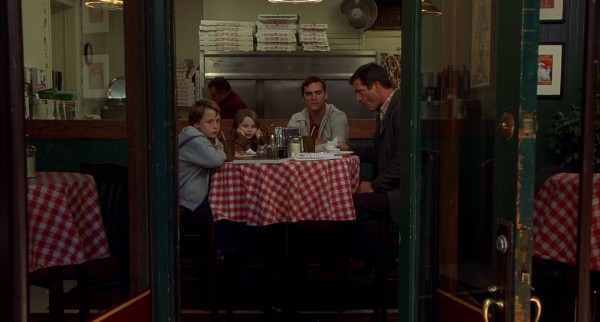
Here the camera movement, as if it is breathing in and out, creates a satisfying mirroring effect between the start and end of the scene. Shyamalan is adept at shaping (segments of) scenes so their start and end will reflect each other, often in non-obvious ways. In the other articles we have already discussed the subtle symmetries of the telescope scene, and the ritualised scene when Graham looks out of the bedroom window during the boarding-up.
In Signs scenes do not only exist to drive the plot forward. Their unusual staging creates additional layers, encouraging meanings and symbols, often enigmatic. M. Night Shyamalan has given this alien-invasion film an inscrutable dimension which makes it always fresh to engage with, always interesting to look at.
*
Addendum A: sound
Sound is used in interesting ways on many occasions.
- wind starts to whistle for dramatic effect in two cases: when Graham is getting his torch to work again just before he stumbles upon an alien in the cornfield, and when Graham says, “Did you see something [of an alien nature], Ray?” during the conversation with Ray Reddy – in the latter scene Graham will soon confront the alien behind the pantry door. Furthermore, the wind suddenly increases after Merrill has thrown a stone into the cornfield in the last exteriorl scene before the family board themselves up in the house. Wind is also making the cornstalks rustle menacingly in many scenes.
- birds shriek in accompaniment to Morgan’s shouts from the cornfield in the opening sequence; crows start to sound off ominously when Graham realises “I don’t hear my children” when the crop circle is examined
- water: the kitchen faucet is dripping during the shots of pots and pans used for preparing dinner and of the family at table (water is connected to aliens, and the faucet underscores their imminent threat at this point)
- doors and boards: during the siege aliens are hammering on various doors; an interior door slams shut before the family retreat into the basement; the scene of the story of Bo’s birth ends with a bang by a plank boarding up a door
- dogs: shockingly sudden barking abounds, in the block-and-reveal shot in the crop circle; when Houdini barks as it rises to threaten Bo; when Isabel lunges at Graham when it is wound up by the alien presence
- mobiles: the four mobiles outside the Hess house are a very important element of the film’s soundscape
- various off-screen sounds: Bo’s extremely high-pitched squeal from outside as Graham brushes his teeth in the opening sequence; Morgan’s shouts from the cornfield just after; aliens running outside before they start attacking the house; the sounds of the dog Isabel is being killed off-screen; Bo crying off-screen when Graham loses his temper at the dinner table; off-screen sounds from the TV when they emerge from the cellar; off-screen merriment in the film’s last shot
Addendum B: odds and ends
This is a left-over item from the first article’s chapter on the film’s many subtle foreshadowings. In the film’s climax, various peculiarities of the characters come together: Colleen’s dying words, Graham’s dormant faith, Merrill’s prowess with a baseball bat, Morgan’s asthma, Bo’s obsession with water – everything is acting in concert to defeat the Nemesis Alien and save their lives. One peculiarity is less emphasised, however: Bo’s high-pitched squeal is only heard during the opening of the film, but far off at its end it turns out to be one crucial cog in the family machinery that will bring the alien down. It is her scream that startles the alien so much that it drops Morgan, enabling Merrill to attack freely.
Furthermore, it is interesting to see how Shyamalan handles the stand-off, where the alien has taken Morgan hostage, holding him in its arms. He is increasing the tension by prolonging the scene to an almost ridiculous extent, with various shots of the characters facing the alien. One of the shots shows Bo, from an angle beneath Morgan’s body (below). Soon, Graham’s epiphany makes him command Merrill to grab the baseball bat, an action that makes the alien release its poison to kill Morgan. Bo reacts by letting loose her scream, shot from roughly the same angle. Thus, the previous shot of her was not just to build tension, but served as forewarning of her crucial scream:
Finally, kudos must be given to Patricia Kalember for her performance as the dying Colleen. She only appears in one scene, the third flashback of the traffic accidents, that is inserted into the stand-off with the Nemesis Alien. Her pained smile and the way she is almost imperceptibly extinguished in the moment of death is acting of highest order. This scene was the first to be shot in the Signs schedule, just a couple of days after 9/11, so it became a death scene with unusual resonance for everyone on set.


